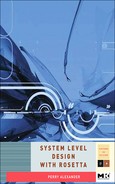The use of heterogeneous models is becoming essential in modern system specification and design. With its rich and extensible set of domains, Rosetta provides a flexible yet rigorous formalism for capturing and bringing together behavior, architecture and constraint definitions from a wide spectrum of diverse engineering sciences. | ||
| --Dr. Roberto Passerone University of Trento | ||
Designing a language is both very difficult and time consuming. Dr. Perry Alexander has shown great commitment and courage in leading the Rosetta Language project to its successful conclusion while commercial EDA companies and some industry analysts had given up on the project. Whether the language will ever attain the commercial success it deserves is immaterial. Perry’s work and that of his two closest collaborators, David Barton and Peter Ashenden, has not only produced a language that allows the rigorous architecture and specification of a system, but its characteristics will influence the syntax and semantics of all future system design languages. Although the case studies presented focus on electronic design, after all the three primary architects are active in the field of Electronic Design Automation, the Rosetta language has a true “system” nature that allows it to be used as a specification language in other domains. Teaching a new language is difficult: after all one only learns a language when one uses it, and yet how can one use it if one does not know it? System-Level Design with Rosetta is an excellent tool for technologists who wish to become Rosetta speakers. Perry is too modest in his Acknowledgment when it says that Rosetta “actually resembles a language.” It not only is a language, it is better than most.” | ||
| --Gabe Moretti Senior Member IEEE and EDA industry expert | ||
Real system designers know that the requirements placed upon the design of advanced electronic products extends well beyond the bounds of functional behavior typical in most other “system-level” languages. Parametric constraints such as cost, weight, power, timing, compliance to standards, and numerous domain-specific requirements often dominate written specifications, yet these have been left out of the automated process of design refinement tradeoffs in EDA tool flows—until now. Rosetta is a breakthrough technology, unique in it’s breadth of expressiveness and adaptability to differing application domains. Firmly rooted in formal semantics, Rosetta promises to enable better scalability and modularity in handling increasingly large and complex electronic systems, whether confined within a single chip or extending through an aircraft carrier. Perry Alexander and his expert team have labored diligently to capture the full needs of system designers and enable representation within a language that is architected for future extensibility. | ||
| --Steven E. Schulz President and CEO of Silicon Integration Initiative, Inc. | ||
Formal methods for system-level design are becoming increasingly important as the complexity of systems escalates. The development of Rosetta is a significant milestone, as it allows designers to capture complex interactions among multiple domains involved in real-world systems in a way that can be formally analyzed by tools. Alexander’s book leads the reader into this exciting new world, explaining both the language and its use in a variety of modeling scenarios. I am pleased to recommend the book to those with an interest in system-level design, whether they be new to the area or experienced practitioners. | ||
| --Peter J. Ashenden Ashenden Designs Pty. Ltd. | ||
